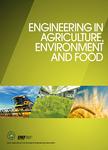版权所有:内蒙古大学图书馆 技术提供:维普资讯• 智图
内蒙古自治区呼和浩特市赛罕区大学西街235号 邮编: 010021

作者机构:Biological Systems Engineering Washington State University PullmanWA99164 United States Department of Biological and Agricultural Engineering University of Idaho MoscowID83844 United States Department of Animal and Veterinary Science University of Idaho MoscowID83844 United States J.R. Simplot Company BoiseID83702 United States Environmental Science Program University of Idaho MoscowID83844 United States
出 版 物:《Engineering in Agriculture, Environment and Food》 (Eng. Agric. Environ. Food)
年 卷 期:2016年第9卷第3期
页 面:257-263页
核心收录:
学科分类:0830[工学-环境科学与工程(可授工学、理学、农学学位)] 0817[工学-化学工程与技术] 0828[工学-农业工程] 08[工学] 0703[理学-化学]
基 金:This research was supported by the College of Agricultural and Life Sciences University of Idaho and the J.R. Simplot Agribusiness Company
主 题:Manures
摘 要:In the present study, the effectiveness of polymer (maleic-itaconic acid) on ammonia (NH3) emissions reduction and in retaining nitrogen (N) in fresh liquid swine manure (SM) was evaluated. The relationship between pH and NH3 emission was also determined. Different doses of polymer (namely Treatment 1 = T1 = 0.8 L polymer/ton of manure, Treatment 2 = T2 = 1.6 L polymer/ton of manure, Treatment 3 = T3 = 2.4 L polymer/ton of manure, and Treatment 4 = T4 = 3.2 L polymer/ton of manure) were added to the SM and its effects were observed for 30 d. The tests results showed significant reduction in pH for T1, T2, T3 and T4 compared to control (C). For the short term (up to 3d) T2, T3, and T4 showed significantly lower NH3 gas concentrations than C, however, for the long term (up to 10–20 d) only T4 continued to indicate significantly lower NH3 gas concentrations. Although numeric observations were reported for other treatments (T1, T2 and T3), no significant differences in NH3 gas concentrations were found. The NH3 emissions reductions were calculated in the range of 81–92%, 31–88%, −39–61%, 6–41%, −106% to −6% for the treatment period of 1, 3, 10, 20 and 30 d, respectively. The addition of polymer resulted in no significant difference in total ammonia nitrogen (TAN) and NO3−–N concentration. However, the addition of polymer had a significant influence on total Kjehldahl nitrogen (TKN) and soluble chemical oxygen demand (SCOD) concentration. The NH3 gas emissions strongly correlated with the manure pH (R2 = 0.911–0.999). © 2016 Asian Agricultural and Biological Engineering Association